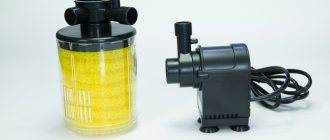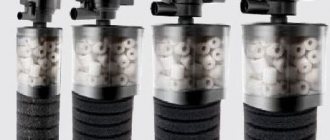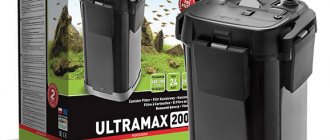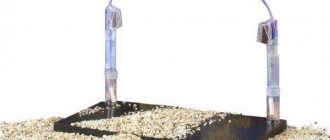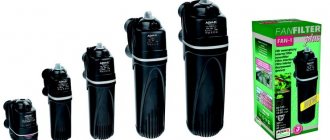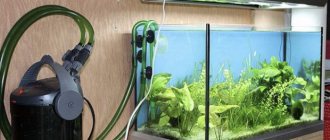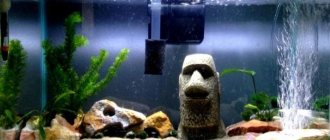What is an aquarium filter and its types
The comfort of the aquarium environment depends on the quality of the water. With the help of filters it is possible to get rid of harmful impurities and organic compounds
Interior
Internal immersion devices are located inside the aquarium and are attached with special suction cups to its walls. The most powerful internal filters are designed for a water volume of no more than 500 liters. However, for most aquarists this is enough.
Internal cleaners are compact and do not significantly reduce the volume of the aquarium. Often, for large volumes, such models are used in conjunction with external devices.
The operation of the filter system is based on the creation of water flow by a built-in pump. Suspended particles rise and are absorbed by the filter. The flow should be moderate.
External
Filters located outside the aquarium are called external or canister filters. Such systems are suitable for volumes of 40-1500 l. Water enters the aquarium through one tube, and filtered water is discharged through another. Externally, filters resemble containers with a cleaning system located inside.
Filters located outside the aquarium are called external filters.
External filters are suitable for fresh and saltwater aquariums.
How to choose?
The first and most important factor that you should pay attention to when choosing a filter is the volume of the aquarium. The small ones will fit small internal filters perfectly. It is distinguished by its budget. easy installation and aeration. Large and professional types of aquariums require a large unit. In such cases, external filters come to the rescue. The main disadvantage of such a device is the difficulty of connecting and expensive maintenance.
The principle of operation of an external filter and what are its differences from the internal one
Typically such systems are located next to the aquarium. They are installed below the water level, into which two hoses are placed: for collecting liquid and for returning it to the aquarium in an already purified form.
The pump is the basis of the filter system. As a rule, it is installed at the top of the device. Under the pump there are filter components contained in a small reservoir (flask). Two tubes extend from the flask (three in models for large aquarium volumes). Some models have a pre-filter or pre-mesh installed on the water intake tube.
Principle of operation:
- Water from the aquarium is drawn into the system by a pump through the intake tube.
- After this, several filter layers pass through.
- The purified water is discharged back into the aquarium.
The main differences between external filters and internal ones are their improved design, a larger selection of filter materials and more effective water purification.
External filters, unlike internal ones, are easier to maintain.
External filters, unlike internal ones, are easier to maintain
Principle of operation
Water purification equipment consists of a sealed canister. It should be installed outside the aquarium and connected at the inlet and outlet using a hose. Waste from the aquarium is drained into the sewer thanks to a sewer pipe that leads from the aquarium. Inside the canister, the water undergoes several types of treatment, including chemical.
They themselves are larger and more powerful. They can hold more filter media and offer better cleaning and support for more fish. That is why most aquarists purchase these filters for large tanks, for example, 200 liters.
Advantages and disadvantages
The advantages of this type include:
- Compactness. Thanks to the small size of the devices immersed in the aquarium, the aquatic environment with its inhabitants looks more aesthetically pleasing.
- High quality water purification. In cases where the filter contains various fillers.
- Quiet operation.
- Combined filtration. The purification system consists of several compartments.
- Durability (service life - more than 8 years).
- Versatile use for fresh and saltwater aquariums.
Disadvantages include the possibility of leaks, high cost and filter size.
Comparison of the presented filters
Based on the rating compiled above, we have organized a table of the main technical parameters. With its help, you can track and compare important nuances for each candidate.
| Model | Power(L/s) | Volume (l) | Dimensions (cm) | Price, rub) |
| Aquael MINIKANI 80 | 300 | 4 | 190x170x385 | 4 500 |
| Aquael UNIMAX 250 | 220 | 4 | 226x270x346 | 4 000 |
| Tetra EX 600 Plus | 250 | 3 | 200x250x240 | 3 800 |
| Aqua Design Amano (ADA) Super Jet Filter ES-600 | 320 | 6 | 60x30x36 | 10 000 |
| EHEIM 2073 professional | 300 | 7 | 358x238x244 | 8 000 |
Canister filter compartments
The cleaning system consists of several departments:
- Mechanical. Dirt particles are caught with a sponge or centipon.
- Biological. A material that serves as a substrate for the development of microorganisms that participate in the neutralization of organic substances in water.
- Chemical. Represented by hygroscopic material (quartz, zeolite, activated carbon).
In most cases, manufacturers offer filters with already distributed filter media. However, there are models in which the user can change the fillers.
The cleaning system consists of several departments
External filters for aquariums - ZhBL, Ekheim, Hagen, Aquael, Dzhebo, etc.
All external filters for an aquarium are divided by power, how many liters per hour it pumps water. This is where almost all manufacturers are a little disingenuous. The pumping speed they claim is achieved only with an “empty” filter without filter materials or with “fresh” uncontaminated substrates. As the substrate becomes contaminated, the filtration rate drops significantly. Therefore, one of the useful rules for choosing a filter is to buy “one size larger.” For example, if you have an aquarium of 150 liters, and you chose “Aquael Unimax 150”, then feel free to buy the next size “Unimax 250” for 250 liters, the money is not much more expensive, and the benefit in more effective biofiltration is obvious. Perhaps only Eheim filters to some extent correspond to the declared power.
By the way, about the pump itself. For some filters it is quite silent, for example, for many models from Eheim, TetraTec, JBL or Fluval. At the same time, filters from Chinese manufacturers are not particularly quiet. Noise can be a problem even for very reliable models, for example, the Eheim Classic series, one of the oldest and most reliable on the market.
Also pay attention to the axis of the pump impeller: it can be metal (cheaper) or ceramic (more expensive, also suitable for marine aquariums). Ceramic is considered wear-resistant and less noisy, but it is quite fragile and expensive to replace. The Aquael filter of the “MiniKani” series has a rather original device, in which the pump is generally located outside the filter canister in the aquarium itself. An unusual solution, but the filter itself is small in size, which is useful when there is a shortage of space.
It would be a good idea to look inside the filter. First of all, you should be interested in the types of filter elements, their location and availability on the market. Most filters are already equipped with all the necessary substrates: sponges of different porosities, ceramic balls or cylinders, gravel, and sometimes even sorbents. However, some filters are equipped only with sponges without ceramic filler. The younger Eheim Classic models are sold without filter elements at all (only fine and coarse sponges). All this can be bought, of course, but it is more convenient to use a ready-made product. Some aquarists recommend using third-party fillers, such as Sera or Hagen. They are cheaper than the original, but no less reliable.
Filling options
The most common fillers are sentipon and foam rubber. Their prevalence is explained by their ability to take any form and act as biological as well as mechanical filters.
Since the spores of the materials develop bacteria necessary to maintain the aquarium ecosystem, if not properly maintained, mucus can clog the system.
The first filter systems used cotton wool, layers of gravel, sand, as well as wool and “fiberglass”.
The following fillers are used at the mechanical cleaning stage:
- Sponges of different densities and cellularity. Stops large polluting particles.
- Filter wool. Its advantage is its low price and suitability for repeated use. Densely packed cotton wool acts as additional protection against leakage. Also, its significant advantage is the possibility of easy cleaning.
For biofiltration the following are used:
- Plastic bioballs. They are excellent as a substrate in which bacteria develop.
- Ceramic rings. The water flow is evenly distributed, due to which the bacteria receive the oxygen necessary for their life.
- Baked glass. The material is available in the form of balls. When baked, pores are formed in the glass, in which bacteria develop that process nitro compounds.
- Zeolite. Inexpensive but effective material. Its main advantage is the immediate absorption of ammonium.
- Ceramic tubes. Beneficial bacteria multiply in the small pores of the material.
Zeolite, an inexpensive but effective material for cleaning an aquarium
Chemical cleaning takes place using fillers:
- Activated carbon;
- zeolites;
- synthetic organic ion exchangers.
Experts do not agree on coal. Some people believe that using small granules is more effective. Before use, you need to evaluate its appearance: there should be many pores on the surface, shine and a light coating.
Best media for external filter
In addition to choosing a filter, you will need to purchase a special filler, which is necessary for biochemical cleaning. If there are no problems with the choice of various large-pored and fine-pored sponges for mechanical cleaning, then how to choose the right filler for chemical water purification.
Currently, there are a variety of fillers on sale, which can be made from plastic, various natural materials, including porous ceramics, lava, and other neutral materials. If you want to save money on purchasing such a filler, we can recommend you various ceramic rings or plastic balls. Experienced aquarists recommend using natural lava as a filler, which is porous and completely chemically neutral.
The best external filters for aquariums
There are quite a few models of purifiers on the market. Let's look at the most popular and well-proven options.
Eheim Classic 350
Manufacturer: Germany. The filter, simple in design, perfectly purifies water. The kit includes taps and sponges for mechanical cleaning. Eheim Classic 350 is one of the best options for cleaning marine and freshwater aquariums with a volume of 120-350 liters.
Advantages:
- ease of installation and operation;
- good performance (620 l/h);
- reliability of design;
- excellent water purification;
- low power consumption.
A simple filter that purifies water perfectly
The filter is equipped with high-quality bearings and a ceramic rotor axis, thanks to which it operates silently.
Tetra EX
Reliable model from a German manufacturer. Suitable for water purification in any aquariums. The design consists of five filter elements, which are located in special baskets. The liquid pressure is regulated using valves. A water pre-filtration function is provided.
Advantages:
- stable work ;
- quiet running;
- ease of operation.
Suitable for water purification in any aquariums
The table will help you select the appropriate Tetra EX model.
| Aquarium capacity (l) | Occupancy type | Recommendation for use with internal filter | Tetra EX Plus model |
| 20-40 | General | No | 400 |
| Vegetable | |||
| 40-60 | General | ||
| Vegetable | |||
| 60-80 | Vegetable | ||
| General | 600 | ||
| Goldfish | Yes | ||
| 80-100 | General | No | |
| Vegetable | |||
| Goldfish | Yes | ||
| African cichlids | |||
| 100-120 | General | No | |
| Vegetable | |||
| Goldfish | 800 | ||
| African cichlids | |||
| Large fish | Yes | ||
| 120-250 | General | No | |
| Vegetable | |||
| Goldfish | Yes | ||
| African cichlids | |||
| Large fish | |||
| 250-300 | General | No | |
| Vegetable | |||
| Goldfish | Yes | 1200 | |
| African cichlids | |||
| Large fish | |||
| 300-500 | General | No | |
| Vegetable | |||
| Goldfish | Yes | ||
| African cichlids | |||
| Large fish | 2×1200 |
Professional aquarists agree that the Tetra EX 600 Plus is the best filter for aquariums with a capacity of 50-100 liters, and the Tetra EX 800 Plus for aquariums with a capacity of 100-300.
The table shows the dimensional characteristics of the models.
| Characteristic | Tetra EX 400 Plus | Tetra EX 600 Plus | Tetra EX 800 Plus | Tetra EX 1200 Plus |
| Length(cm) | 21,16 | 21,16 | 21,16 | 26,32 |
| Width(cm) | 21,16 | 21,16 | 21,16 | 26,32 |
| Height (cm) | 31,4 | 36,4 | 41,2 | 49,51 |
| Inner diameter of hoses (cm) | 1,2 | 1,2 | 1,2 | 1,6 |
| Length of each hose (cm) | 150 | 150 | 150 | 150 |
| Electric cable length (cm) | 165 | 165 | 165 | 165 |
Aquael Unimax 500
The device from the Polish manufacturer belongs to the category of canister filters. Cleaning takes place in three ways: mechanical, biological and chemical. The model is considered the best for aquariums with a volume of 250-500 liters.
Advantages:
- reliability of design;
- economical energy consumption;
- ease of operation;
- silent operation.
Reduced noise levels during operation are ensured by the ceramic rotor axis.
The model is considered the best for aquariums with a volume of 250-500 l
JBL CristalProfi
A filter from a German manufacturer is used for mechanical and biological purification of water in marine and freshwater aquariums. In the presented line, JBL CristalProfi e401 is considered the best for aquariums of 120 liters, JBL CristalProfi e1501 - for tanks with a capacity of up to 600 liters.
Advantages:
- high performance;
- ease of maintenance;
- energy saving;
- the presence of a quick launch function;
- reliability of the design.
The disadvantages include the lack of a prefilter. Algae contamination requires frequent filter replacement.
This filter has high performance and ease of maintenance
Hydor Professional
The budget and reliable Italian model features a system of five filters. Water is purified by biological and mechanical methods. Activated carbon and a sponge placed in different containers are used as filler.
Main advantages:
- affordable price;
- convenient design;
- silent operation;
- quick start function;
- ease of operation.
The filter is used to clean aquariums with sea and fresh water. Leakage is prevented by special gaskets that can be easily removed when cleaning the filter.
The filter is used to clean aquariums with sea and fresh water
Eheim eXperience
Basic professional model from a German manufacturer. The body is made of plastic and has a square shape. Suitable for cleaning freshwater and marine aquariums.
The filter is easy to care for. Full or partial cleaning is possible. Safe operation is guaranteed thanks to the safety adapter. A prefilter is installed on the pipe for collecting water from the aquarium.
Advantages:
- efficiency;
- efficiency in energy consumption;
- quiet operation;
- presence of a prefilter.
The system provides mechanical, biological and chemical filtration.
Safe operation is guaranteed thanks to the safety adapter
Hagen Fluval
An Italian-made filter is a good option for cleaning marine and freshwater aquariums. The complex system includes stages of mechanical, biological and chemical treatment.
The powerful motor consumes electricity economically, which is a significant advantage of the filter. The design is easy to use, easy to assemble and disassemble. The filter consists of 4 types of fillers.
Advantages:
- high performance ;
- good price-quality ratio;
- reliable design;
- quiet work.
The downside of this brand is the possibility of faucets leaking.
Powerful motor saves energy
Aquael Maxi Kani
System from a Polish manufacturer. It is a device with a remote pump.
This model of canister filters can work as an external and internal filter
.
Pros:
- reliable operation;
- high performance;
- convenient design;
- avoiding leakage;
- ease of use.
The disadvantages include the possibility of problems occurring when turning on the filter installed above the water level in the aquarium.
It is a device with a remote pump
AQUAEL Versamax 1
A mounted model that can create a waterfall effect in an aquarium. The device maintains the necessary aeration of the aquatic environment and humidity in the room.
Advantages:
- ease of use and management;
- possibility of using various fillers;
- silent operation.
The manufacturer provides sponges that perform mechanical and biological cleaning functions, which, if desired, can be replaced with other fillers.
The device maintains the necessary aeration of the aquatic environment
Aquael Versamax Mini
The model is relevant for water purification in small tanks with a volume of 10-40 liters (nanoaquariums, shrimp aquariums). The device is equipped with external performance control.
The kit includes replaceable and additional cartridges, which the user can choose independently depending on the characteristics of his aquarium. The filter is mounted on the wall, which does not negatively affect the design.
Advantages:
- compactness;
- convenient equipment;
- low cost.
The disadvantages include the noise of the device. When turned on, vibrations are created on the glass of the aquarium.
The disadvantages include the noise of the device
Sera Fil Bioactive
The filter is made in China under the control of a German company. A special feature of the model is a built-in ultraviolet sterilizer, which allows you to get rid of pathogens and algae at the beginning of their development.
Advantages:
- economical energy consumption;
- reliable operation and long service life;
- silent operation;
- ease of maintenance;
- ease of starting the system.
The system is designed to purify fresh water only. The model is equipped with a special nozzle, thanks to which the water in the aquarium is saturated with oxygen.
Filter made in China under the control of a German company
SICCE WHALE
The most common model in Russia from an Italian manufacturer. The body is made of glossy plastic. There are special openings for carrying. The cleaning system is represented by four baskets with fillers.
Pros:
- high-quality assembly;
- ease of starting the device;
- high performance;
- powerful pump.
The models are noisy. Another disadvantage is the lack of a sprinkler included.
The most common model in Russia from an Italian manufacturer
ATMAN DF
Chinese made system. It has a simple design that is easy to assemble and disassemble. Water passes through three baskets with various fillers, while being fully saturated with oxygen.
Advantages:
- no risk of leakage;
- ease of maintenance;
- reliability;
- high performance.
A special feature of the DF series is the location of the outlet and inlet valves on one panel.
Has a simple design that is easy to assemble and disassemble
Eheim Professional 4
The model from the German manufacturer is used for marine and freshwater aquariums. The high performance of the filter is due to the new generation suction adapter. The design is made of durable plastic and is highly wear-resistant.
Advantages:
- economical energy consumption;
- cleaning efficiency;
- high performance;
- high build quality;
- silent operation.
The package includes lubricant for the profile rubber gasket. Filter media are located in different cassettes.
This filter has economical energy consumption
Hagen Fluval FX6
Powerful filter for aquariums up to 1500 l. The manufacturer claims the ability to purify 2130 liters of water per hour. Cleaning takes place in three stages: mechanical, biological, chemical. The device is suitable for marine and freshwater aquariums.
The system is equipped with a monthly maintenance indicator, which makes it convenient to monitor the regularity of cleaning.
The main advantages are considered to be low energy consumption with high power of the device, high quality cleaning and ease of operation and maintenance.
Powerful filter for aquariums up to 1500 l
Jebo
The model belongs to the type of seamless tanks. Its main advantages:
- ease of installation and use;
- low cost;
- a wide range of;
- decent equipment.
The main disadvantages noted by users are unreliable design and noisy operation.
The model is a seamless tank type
Laguna UVF-3328
Filter made in Russia. Conducts multi-stage purification and UV irradiation of water. Capacity of 2200 l/h is designed for high-volume tanks.
The advantages include:
- possibility of replacing fillers;
- quality of assembly and consumables;
- avoiding leakage.
The only downside is the high price of the device.
The filter carries out multi-stage purification and UV irradiation of water
Filtration in the aquarium. Canister filter - questions and tips.
Aquarium science begins with choosing an aquarium and a filter for it. Previously, an aquarium filter could only be seen among aquarists who were professionally involved in fish breeding and very rarely among hobbyists.
A filter is a device for purifying (filtering) any environment. Accordingly, an aquarium filter is designed to purify water.
There are two types of filters on the market used by aquarists: external and internal. External ones are divided into canister and suspended ones, and internal ones into “heads”, glass type, bottom and internal biofilters. Today, external filters have firmly taken their place among aquarists.
If you decide to install an aquarium in your apartment, house or office for a long time, then the first step after choosing an aquarium is choosing an aquarium filter. In this article we will look in detail at what a canister filter is and why it is needed.
Why is filtration in an aquarium so important?
To understand this issue, let's look at a simplified biological process that occurs in a functioning aquarium.
Organic substances constantly appear in aquarium water. The main source of these substances are waste products of living aquatic organisms, uneaten food for fish and shrimp, dead organisms, and rotting leaves of aquarium plants.
All of these sources together present a bigger problem than we think. Organic matter in aquarium water will inevitably break down, forming nitrites, nitrates (NO3), ammonia (NH3) and ammonium (NH4). The most dangerous of them is ammonia, an extremely harmful substance that has a detrimental effect on the health of fish.
WHAT TO DO WITH THESE HARMFUL SUBSTANCES?
The main assistants in the processing of these substances and compounds are nitrifying bacteria. These small organisms settle inside the aquarium filter and are constantly “working”.
- One type of nitrifying bacteria, Nitrosomonas, converts ammonia into nitrites (NO2) by oxidizing the former. Nitrites are also of little use and have a detrimental effect on the health of fish; moreover, when the concentration reaches 0.2 mg/l, they can have a detrimental effect.
- Another type of nitrifying bacteria, Nitrobacter, converts nitrites into nitrates by combining the former with oxygen. As a result, we get less toxic, but much needed NO3 nitrate in the aquarium. The critical concentration of nitrates in an aquarium is 50 mg/l.
It’s easy to guess that the more nitrifying bacteria there are, the faster the process of converting harmful compounds into harmless ones occurs. The number of bacteria directly depends on the surface area on which they settle. Therefore, the larger the aquarium, the larger the filter needed. An internal filter filled with an ordinary sponge to accommodate the bacteria we need is ineffective.
Let's see what sponge fibers and professional bio-filler look like under a microscope.
PHOTO TAKEN AT 30X ZOOM
The photo clearly shows that an ordinary sponge has a very small “usable area”. The colony of nitrifying bacteria settling on the surface of the sponge will be extremely small for the effective processing of ammonia and nitrites. Unlike a regular sponge, professional bio-fillers have a large usable surface area and porosity for the bacteria we need to settle on it.
For bio-fills, the most important aspect is that the oxygenated aquarium water must reach the bacteria. Therefore, the “pore holes” on the surface should not be too deep, since the flow of water into deep holes will be insufficient and vital oxygen will not flow in the required quantity to the bacteria.
Chemists say that the rate of nitrification directly depends on the oxygen concentration.
Considering the internal filter, namely its useful volume for placing filter materials in it, you can understand that it is too small. The small size of the external filter provides little potential for biofiltration.
Beginning aquarists often debate the potential of internal sponge filters. The main aspect of disputes is their cost. Yes, of course, if you consider a small aquarium with a volume of 30 liters, you can select the necessary internal filter, in which you can place other filter media in addition to the sponge. With such a filter you can successfully achieve a stable balance in a small aquarium. But if we consider installing such a filter in a larger aquarium, then it will be extremely difficult to achieve good filtration in the aquarium.
Water movement is the most neglected but very important aspect of aquarium health. Properly organized water movement promotes the absorption of floating particles of small solid debris, large plant and food residues into the intake tube of the external filter, which decompose inside the filter.
Proper water circulation also plays an important role in the distribution of carbon dioxide and the delivery of nutrients to aquarium plants. There is no need to create too much water flow; this is unnecessary for either plants or aquarium fish. Our goal is to create a flow like in a river - wide, uniform, with a slow flow along the entire aquarium.
To realize this, Aqua Design Amano specialists came up with a completely new method of creating water flow in an aquarium. This is done using special water intake and discharge tubes, the so-called Lily Pipe Outflow and Lily Pipe Inflow, and installing them in a special way.
Lily PipeOutflow is an ingenious and simple invention that performs three most important functions in an aquarium:
- creates proper water movement in the aquarium
- cleans the water surface from film and floating particles
- if necessary, can aerate the water
ORGANIZING CORRECT WATER CIRCULATION IN THE AQUARIUM
With this scheme, the circulation of water is uniform throughout the entire volume of the aquarium, and it is not interfered with by thickets of plants. Suspended particles, usually floating and accumulating at the front wall of the aquarium (residues of food, fish excrement, silt, etc.), are immediately carried away by the current to the filter intake tube, rather than settling in the thickets of plants and corners of the aquarium. In addition, there are no areas of too fast water movement, which algae love so much.
Today, you can find different water intake and discharge tubes on the market; they come in different configurations and are made of different materials (plastic, glass, stainless steel). It is impossible to say unequivocally which of them are better and which are not.
The choice of water intake and discharge tubes remains with the aquarist.
We recommend purchasing glass tubes; they fully satisfy the necessary needs for organizing water circulation and look very elegant. The only thing you need to pay attention to is special care when removing or cleaning them.
External filter selection
There is a huge selection of external canister filters on the market with various filter media. If we consider bio-fillers for biological treatment, we can find ceramic rings, bio-balls, tubes, small lava stones, and all kinds of professional bio-fillers. The vast majority of filter materials existing on the market are the result of the financial struggle of manufacturers for a potential buyer. As a rule, they are all more or less similar in their characteristics and sufficiently cope with the task assigned to them. After all, even premium manufacturers sell thousands of different products on the market, advertising them as the best on the market.
A novice aquarist is faced with the question of choosing a filler for biological filtration based on budget or perhaps some personal beliefs.
When choosing and purchasing an external filter, we recommend that you pay attention to the fact that it has three main sections for filtration:
- Mechanical coarse filtration
- Biological filtration
- Mechanical fine cleaning
1. MECHANICAL FILTRATION
Removes mechanical suspensions and other dirt from the aquarium. As a rule, this is a pair of large-porous and/or medium-porous sponges 2-3 cm thick. They should not be thick, the only purpose is to protect the biological filter material from clogging. Since the role of the sponge in biological filtration is negligible, it can be washed in ordinary tap water. There is no need to change the sponges in the external filter, since it does not lose its properties even after several years. They will only need to be replaced if there is sufficient wear.
2. BIOLOGICAL FILTRATION
It is important that this section contains high quality filter material so that it is porous enough to allow valuable colonies of nitrifying bacteria to settle on it. This material should occupy most of the capacity of the external canister filter. We wrote above that an ordinary sponge is not suitable for effective biological filtration.
When servicing the external filter, do not rinse the biological filter media in chlorinated tap water. Aquarium water poured into a prepared container is best suited for these purposes. Since the biological filtration media only acts as a surface for bacteria, it does not need to be changed frequently.
It is not recommended to turn off the external filter for a long time, since bacterial colonies at this time remain without oxygen and are guaranteed to die.
Rapid recovery of biological filter material or regeneration due to a power outage/long-term stoppage of the filter can be accelerated by preparations with live bacteria to “start up” the filter.
3. MECHANICAL FILTRATION
In the fine mechanical filtration section, aquarium water is purified from finer suspended matter. As a rule, a fine-pored filter material - synthetic winterizer - is used for these purposes. If this material becomes contaminated, the filter's performance drops sharply. For normal operation of the external filter, this material must be periodically replaced with a new one.
4. CHEMICAL FILTRATION
Chemical water purification is not necessary in an aquarium. It is used if there is a problem with water. The purpose of chemical filtration is to retain toxic substances. It uses a variety of fillers such as activated carbon, zeolite and ion exchange resins. Activated carbon has a highly porous microstructure, thanks to which it effectively removes (adsorbs) toxins, acids and unnecessary trace elements. Most often, activated carbon is used in filters after treating fish in an aquarium. for the purpose of removing drug residues from aquarium water. Zeolites are also powerful adsorbents due to their structure.
When using chemical cleaning, it is necessary to monitor the cleanliness of the filter and change the fillers according to the manufacturer's instructions.
Fillers accumulate all the harmful substances in themselves, and if you do not change them on time, filtration will be useless or may even harm the aquarium!
When can you add fish to the aquarium? Why should I wait 2-3 weeks?
It is important to know that colonies of nitrifying bacteria will not immediately appear in the aquarium filter, much less in the required quantity. It takes time for them to reproduce. Even if so-called preparations with live bacteria are used at startup, it takes approximately 2-3 weeks for them to multiply and “ripen” the biofilter. To quickly start the external filter, you can additionally add aquarium water from an existing healthy aquarium. Another way to speed up the “maturation” of a biofilter is to add the so-called “squeeze” from the existing aquarium filter to the new filter.
Important!
- Bacteria that have settled in the external filter constantly need oxygen, which is extracted from the aquarium water. For this reason, external filters should never be disconnected from the electrical network. When performing maintenance, care should be taken to avoid long-term shutdowns.
- It is forbidden to wash biological filter fillers in chlorinated tap water; this procedure will lead to the death of nitrifying bacteria.
Which external filter should I choose?
After reading this article to the end, we figured out the role of the external filter in the processes occurring in the aquarium. Before choosing and purchasing an external filter for your aquarium, you must consider the following criteria:
- You need to choose a filter based on the volume of the aquarium;
- ease of maintenance;
- manufacturer (do not choose a little-known brand);
- reliability;
- price-quality ratio;
- owner reviews
It is also worth noting that cheaper models of external filters, as a rule, contain lower quality filter materials, and after purchasing them in addition, the final cost will not be so small.
In our online store we have tried to present the most reliable and popular models of external filters from reputable well-known manufacturers in terms of price/quality ratio. It is important to remember that buying an external filter is a foundation for the future; the most important thing is that the aquarium filter is reliable, quiet, easy to maintain and has a long service life of at least 8-10 years.
If you decide to buy an external filter and find it difficult to choose, our specialists will definitely advise and help you choose the necessary model. You can view the range of external filters for aquariums in the External filters section
If you liked the article, then repost or share your knowledge with your friends!
© Copying of materials presented on this site is permitted only if there is an active backlink.
How to choose
When choosing a filter, it is important to pay attention to its technical characteristics and the individual characteristics of the aquarium.
Performance
Read the manufacturer's recommendations carefully. The capacity of the aquarium should be slightly smaller than the recommended volumes. If the aquarium is densely populated with inhabitants, then you need a filter with a good performance reserve.
Approximate performance figures depending on aquarium capacity:
- 30-70 l - 300-400 l/h;
- 60-100 l - 500 l/h;
- more than 100 l - 700 l/h.
When choosing a filter, first of all you need to pay attention to the power it consumes. The optimal value is 10 W. To purify large volumes of water, devices with a power of 16 W are relevant.
The choice of performance is based on the volume of the aquarium. It is recommended to choose devices that purify a volume of water in an hour that is three times the capacity of the aquarium (for example, for a two-hundred-liter aquarium, we select a filter with a capacity of at least 600 l/h).
When choosing a filter, you need to pay attention to the power it consumes.
Canister size
Typically, external filters are installed in an aquarium cabinet. When choosing a cleaner, you need to evaluate:
- its dimensions (height, length, width);
- presence of holes for hoses in the cabinet;
- diameter and length of the device hoses.
The filter should fit completely into the cabinet, and the hoses should comfortably pass through special holes and reach the aquarium.
Filter complete set
Some manufacturers provide the user with the ability to choose fillers. This is not always convenient, especially for beginner aquarists. When choosing a filter, you need to pay attention to the presence of the necessary fillers.
The quality of cleaning depends on the amount of biofiller. The optimal amount is considered to be 1-3% of bioceramics or 4-10% of bioballs from the total volume of the aquarium.
The quality of cleaning depends on the amount of biofiller
It is necessary to evaluate the load of algae and underwater inhabitants: the more there are, the more bacteria are required for the biobalance of the environment.
Has a quick launch button
The function eliminates difficulties when starting the filter for the first time, as well as when turning it on again after cleaning. Without a quick start button, you must suck water into the hose with your mouth.
Availability of prefilter
A filter installed on the pipe that supplies contaminated water to the filter greatly facilitates the maintenance of the device. The quality of filtration with a prefilter increases and the need for maintenance is reduced.
Availability of consumables and spare parts
Over time, consumables require replacement. Therefore, when purchasing a filter, you need to evaluate their availability. It is best if parts and components can be purchased at your local store or easily ordered from online stores.
Comparison of the presented filters
From the rating presented above, we have collected all the characteristics and inserted them into a special table, from which you can determine and track the points that are important to you.
| Model | Power (hp) | Volume (l) | Dimensions (cm) | Price, rub) |
| Tetra IN 600 Plus | 4 | 100 | 30x8x7 | 3 500 |
| Aquael TURBO-500. | 4.4 | 150 | 70x76x239 | 6 000 |
| Hagen FLUVAL | 4.8 | 20 | 33x37x54 | 3 000 |
| Eheim aquaball | 4.5 | 20 | 21x10x9.5 | 2 600 |
| Dennerle Nano Clean Eckfilter | 2 | 19 | 20x11x7 | 1 500 |
How to install
Each manufacturer offers detailed instructions for installing the device.
The general scheme is as follows:
- We prepare rags and stands in advance in case of leakage.
- We assemble the filter according to the accompanying user manual. Open the valves on the lid at the end. We choose ceramics or bioballs as the first layer of filler, then we lay down sponges and padding polyester. The final layer is chemical.
- We estimate the length of the hoses. We secure the water intake hoses.
- Before starting, completely fill the filter with water by gravity.
- We install the water discharge hose, close it, pour water into the free end and connect it to the outlet.
- Open the faucet and connect the device to the power supply.
When installed correctly, water movement is noticeable. From time to time, air may accumulate in the system, causing the water supply to stop. In this case, either restarting the filter or draining the water hoses and refilling them with water will help.
When installed correctly, water movement is noticeable
Subtleties of operation and rules for caring for an aquarium filter
The first weeks the purifier works mechanically. Gradual pollution leads to a decrease in water pressure, but this also has its advantages. Accumulating organic compounds act as food for bacteria, that is, biological self-cleaning of the device occurs.
The further condition of the filter depends on the severity of the contamination and the degree to which it resists the vital activity of bacteria beneficial to the aquarium. Cleaning and restarting the filter is required when its capacity drops below 30% of maximum. Self-cleaning can prevail over contamination, and productivity that has dropped to 50-70% is restored.
To reduce the rate of pollution, it is necessary to protect the water intake with a prefilter.
The proper operation of the device directly depends on its correct and timely cleaning. Without maintenance, work efficiency decreases. In the case of internal structures, the aquatic environment is also polluted.
To preserve beneficial microflora, the device should not be washed very thoroughly, using water at room temperature (it is advisable to use aquarium water).
You cannot wash the filter in the following cases:
- changing the water in the aquarium;
- launching new fish;
- change of feed.
Particular attention is paid to replacing sponges. A sign of wear is loss of filtering ability and shape. In indoor appliances, the sponge consists of several parts. You need to wash it not entirely, but in parts. This will maintain a colony of beneficial bacteria.
Particular attention is paid to replacing jaws
The question often arises about the need to turn off the device before feeding the fish and when taking water. Continuous operation of the filter is recommended for two main reasons:
- At the moment of startup, the device’s mechanisms are under maximum load, which reduces their service life.
- Human factor. The aquarist may forget to turn on the device.
To ensure that the device remains operational when changing the water, the water intake should be located in the lower part of the aquarium.
Turning off a sufficiently dirty filter for a long time (at night, while leaving) can kill the inhabitants of the aquarium.
The best mounted and bottom filters
Sometimes the only solution for small containers is mounted or bottom filters. An attachment (sometimes called a “backpack”) is attached to the wall of the tank, lowering the intake tube into the water, and the filtered water flows back into the aquarium as a waterfall.
For nano-aquariums with a capacity of up to 10 liters, a backpack is an ideal option. The unusual feature of the bottom unit is the prefabricated structure of the false bottom, under which water is pumped. Rising upward under pressure and carrying debris with it, it is sucked into the external or internal filter by the water intake.
Eheim Undergravel 3540
4.9
★★★★★
editorial assessment
94%
buyers recommend this product
See review▶
An unusual and easy-to-use bottom filter will allow you to forget about cleaning the soil forever and will ensure constant water movement around the entire perimeter of the aquarium. Under the artificial bottom made of prefabricated plates there is a system of water supply tubes connected to a pump and mechanical filter. Clean water is pumped and rises from below through the soil poured onto the false bottom, taking with it dirt, which is sucked into the tube and passes through the filter.
Thus, the soil itself, populated with purifying bacteria, turns into a biofilter. The entire system is easy to assemble, and the plastic bottom plates are attached with spring clips and form any bottom shape.
Pros:
- stagnant zones do not form at the bottom;
- plants grow well;
- the bottom plates are very strong;
- all necessary spare parts are supplied included;
- lifting price.
Minuses:
- The standard bottom size is 80x35 cm, additional plates can be purchased separately.
The filter is suitable for use in both fresh and sea water. The manufacturer does not recommend keeping a large number of large bottom-dwelling fish in an aquarium with such a system. During quarantine treatment, the purification system should be turned off.
Useful tips
Experienced aquarists advise following several rules when using aquarium filters:
- It is recommended to rinse frequently only sponges for mechanical cleaning. Occasionally you need to wash the remaining compartments. This way, the biological balance in the aquarium environment is preserved as much as possible.
- When making a homemade filter, it is important to use elements that are free of lubrication and protected from corrosion. Even a small amount of oil can kill aquarium inhabitants.
- It is important to use transparent hoses made of food grade silicone. They are safe for aquatic life, and the transparent material allows you to monitor the contamination of the tube.
An external filter is a must-have device for an aquarium. The choice of a suitable system is influenced by the capacity of the tank and the characteristics of its inhabitants. When purchasing, you need to pay attention to the filter surface area, the uniformity of water flow, as well as the availability of components and spare parts.
What kind of external aquarium filter do you use: purchased or homemade?
Why is such equipment needed?
To maintain optimal conditions in the aquarium, it is necessary to perform mechanical and chemical water purification . It is for this cleaning that the filter used in the aquarium is responsible, which additionally mixes the water, ensuring its saturation with oxygen. Today, there are several fundamentally different types of such equipment:
- Internal;
- Mounted;
- Bottom;
- External.
As you can understand from the name, the internal filter in the aquarium is located directly in the aquarium, providing mechanical cleaning to a greater extent. But an external filter for an aquarium uses a special substrate with colonies of bacteria, which allows you to purify water not only from mechanical impurities, but also from nitrates, nitrites and other waste products of fish.
If in the recent past the simplest internal structures were most popular, today an increasing number of aquarists are inclined to install external equipment that is simultaneously capable of mechanical and chemical cleaning, while it is reliable, does not take up space inside the aquarium and is affordable.

